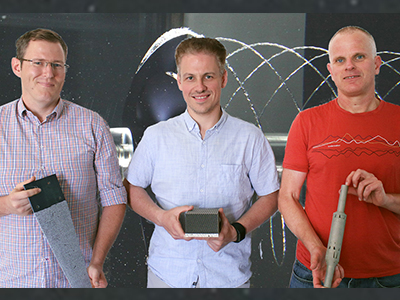Cavitation and correlation down under

DST will be showcasing its support of Australian Defence’s maritime activities at the PACIFIC 2019 international maritime exposition. PACIFIC 2019 is being held in Sydney from Tuesday 8 to Thursday 10 October 2019, and DST’s presence will be aligned with the five focus areas outlined in DST’s Maritime Domain S&T Strategic Plan. Those focus areas are: Decision Superiority, Mission Survivability, Joint and Combined Operations, Creating and Shaping the Future Force, and Seaworthy and Airworthy Fleet.
One of DST’s key activities supporting RAN mission survivability, and which will be highlighted at PACIFIC 2019, is our research in the area of hydrodynamics. Understanding hydrodynamics is critical in evaluating the performance of hull shapes, control surfaces and propulsion for naval platforms. These issues impact a platform’s range, manoeuvrability, acoustic signature and impact fatigue.
Defence scientist Dr David Clarke and colleagues have been developing a range of innovative experimental capabilities, some unavailable internationally, to study hydrodynamics and support Defence in its acquisition, sustainment and understanding of naval platforms. These new capabilities are implemented in the variable pressure water tunnel, or cavitation tunnel, in the Cavitation Research Laboratory (CRL) at the University of Tasmania (UTAS).
UTAS, DST and Defence have invested significantly in the CRL over more than 20 years. Under the guidance of Professor Paul Brandner, the CRL facilitates unique, world leading hydrodynamic measurement capabilities enabling DST to conduct high value experimental investigations in support of Australian Defence and international collaborations. This relationship between DST and the CRL has been active for over 20 years.
Highest quality water found in Tasmania
The test section where the team test model propellers and appendages is small compared to the overall structure, most of which is dedicated to conditioning the water flow before it reaches the model. “Apart from the flow being uniform and with low turbulence, the Tasmanian facility is one of only a few in the world that has fine control over nucleation,” explains Clarke. “It has the smarts to strip out small bubbles and inject new ones of the correct size – nuclei are one of the two major components that need to be controlled to investigate cavitation. Local pressure is the other major component.”
One prime example of innovative capabilities on offer is 3D digital image correlation (DIC). To measure the deflection and vibration of items, the team trialled an innovative photogrammetric technique which had been used before in wind tunnels but not in a cavitation tunnel where the range of refractive indices makes getting suitable image quality difficult. A unique pattern is painted on the item being examined. By recording and then correlating how that pattern moves from frame to frame through a sequence you can get well below sub-pixel precision in movement detection. “We were the first in the world to publish on getting such a capability to work in a cavitation tunnel,” explains Butler. “The noise floor for measurements is now sitting about 20-30 nanometres.”
It all adds up to DST being able to provide high quality testing on a mid-range scale to give a good degree of confidence in its computational models. According to Clarke, experimental testing on a larger scale is very expensive. He says testing at an early stage and developing competency in analysing results and understanding the fluid mechanics of a system or component is very valuable.

